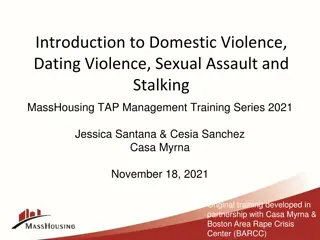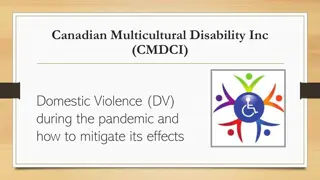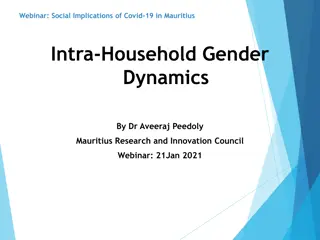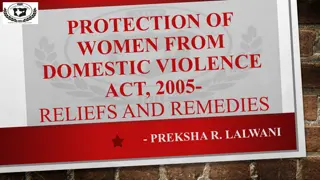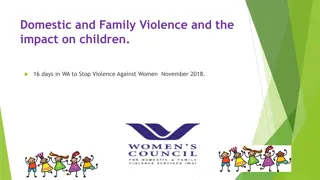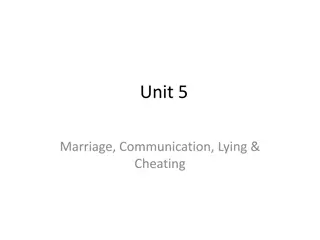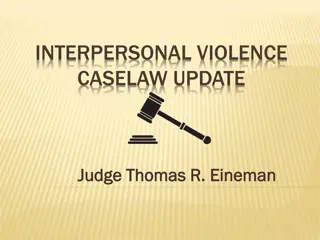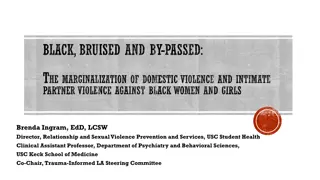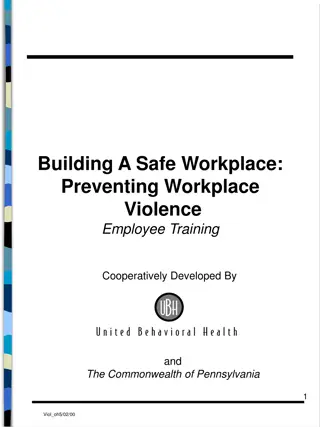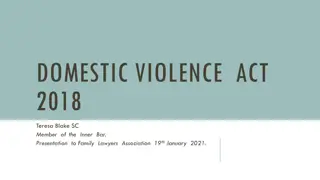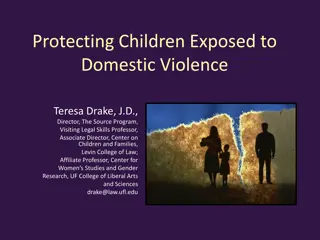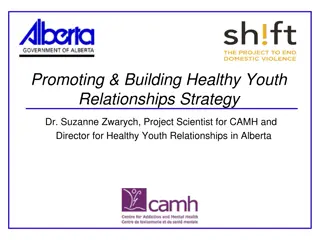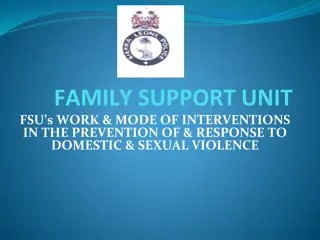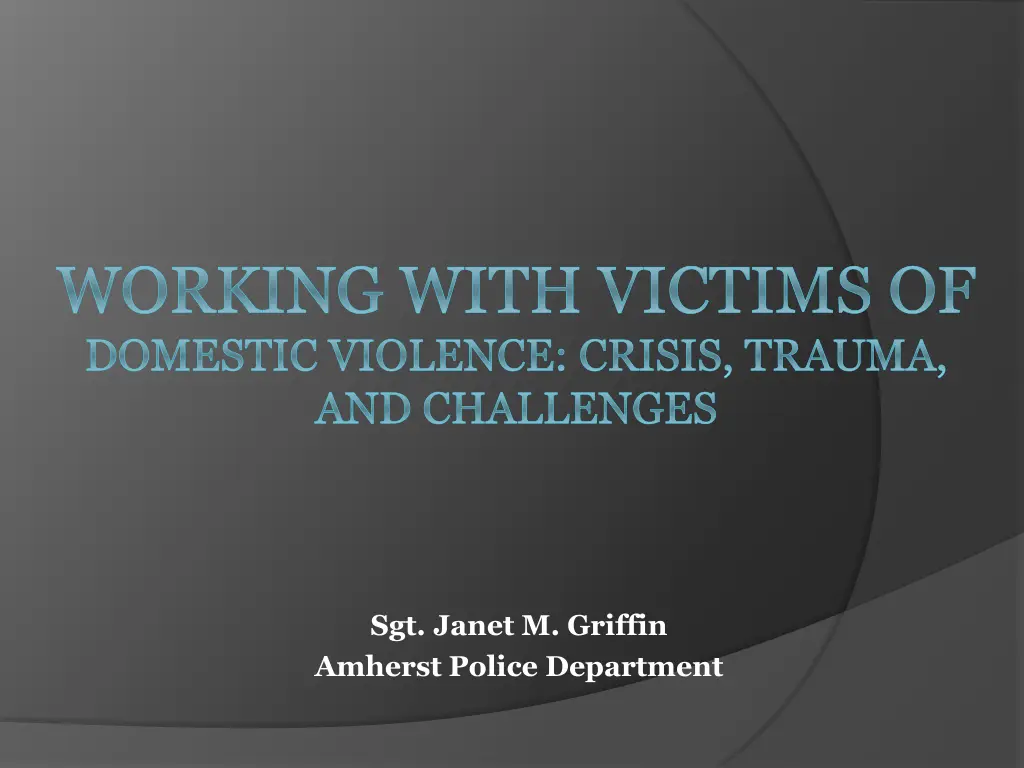
Understanding Dynamics of Trauma in Domestic Violence Situations
Learn about the crisis, trauma, and challenges faced by victims of domestic violence, including reasons for delayed reporting, victim responses, trauma dynamics, and challenges in responding effectively. Gain insights into supporting victims and enhancing community responses.
Uploaded on | 0 Views
Download Presentation

Please find below an Image/Link to download the presentation.
The content on the website is provided AS IS for your information and personal use only. It may not be sold, licensed, or shared on other websites without obtaining consent from the author. If you encounter any issues during the download, it is possible that the publisher has removed the file from their server.
You are allowed to download the files provided on this website for personal or commercial use, subject to the condition that they are used lawfully. All files are the property of their respective owners.
The content on the website is provided AS IS for your information and personal use only. It may not be sold, licensed, or shared on other websites without obtaining consent from the author.
E N D
Presentation Transcript
WORKING WITH VICTIMS OF DOMESTIC VIOLENCE: CRISIS, TRAUMA, AND CHALLENGES Sgt. Janet M. Griffin Amherst Police Department
Reasons A timely, logical and sensitive response increases reporting, enhances community confidence, and strengthens investigations thereby facilitating successful prosecutions. Responding to the victim with dignity, respect and sensitivity will facilitate their participation in the justice system, and increase offender accountability
What is Crisis? A perception of an event or situation as an intolerable difficulty that exceeds the resources and coping mechanisms of the person Unless the person obtains relief, the crisis has the potential to cause severe behavioral malfunctioning
The Victim Thinking pattern or belief system may be the primary reason victim does not seek help. Rigid thinking patterns by victims can drive them to respond in ways that appear illogical or unhealthy. Victim s core response to abuse is generally focused on self-preservation or keeping the children safe. 1)Fear 2)Self blame 3)Denial
Dynamics of Trauma Age Coping skills Culture or belief system Neurobiology Severity of crime Relationship to offender Previous exposure to crime or violence Previous experience with CJ system Availability / effectiveness of overall support systems
Trauma response This can result in shock, dissociation and many other kinds of involuntary responses while the violence is happening. Anger Distrust Substance use/abuse Trouble regulating emotions Hopeless Struggle with memory recall
Trauma challenges Pacing-talking fast Not talking at all Slow to answer questions Unable to listen and/or understand what you are asking Unable to read or comprehend Confused memory - unable to recall details Confusion as to time frame (20 minutes is 3 minutes) Inability to focus or make a plan
Flight/Fight/Freeze Dissociation Stages Beyond conscious control, victim does not get to choose Feeling unreal, spacing out, check out completely Immediate: Shock Denial Fear Shame Focus on object in room or memory Freeze: Brain detects an attack & prohibits movement Disconnect from the intimate violation that s happening Outward adjustment: Coping mechanisms crash Isolation Anxiety/Depression Sleeplessness Difficulty functioning Brain & body paralyzed with fear - unable to move or speak. Fight/Flight: Fight effectively or Able to escape assault Fragmented memory/holes in account of assault Re-triggering/Resolution: Anniversary of traumatic event Not going away May be crying or passively trying to get away from threat Have to go home now
Verbal de-escalation Empathy Direct identification with, understanding of, and vicarious experience of another persons situation, feelings and motives The experience of understanding another person s condition from THEIR perspective Non-judgmental Avoiding judgments based on one s personal and moral standards Acceptance and awareness Active listening A conscious effort to hear not only the words that another person is saying but, more importantly, try to understand the complete message being sent Block out distractions
What to DO Speak in calm, slow and clear voice You may need to repeat yourself Be patient / empathetic Try to reduce background noise/distractions Ask open-ended questions Obtain relevant info from others (family, friends, etc.) Respect dignity of individual without regard to sex, race, age, sexual orientation
Physical de-escalation Maintain calm composure Use slow, deliberate movements Body language Neutral face expressions Personal space Attempt same height and eye level
What to AVOID Crowding or cornering the individual Touching the individual unless you ask first or its essential for safety Minimizing abuse Inflammatory language ( you re acting crazy ), victim blaming Shouting or giving rapid commands Making promises you may not be able to keep Telling the individual I know how you feel
Best practices: Offender accountability Inform the victim of your concern Give victim rights Provided safety planning & options Connect with resources They made me feel I was not to blame or at fault and not crazy
Its everyone's responsibility to treat people in a manner that provides the utmost respect and inclusion in the decisions that affect their lives, so they can participate fully in their own recovery process
Resources 2017 DV guideline DA s Office

